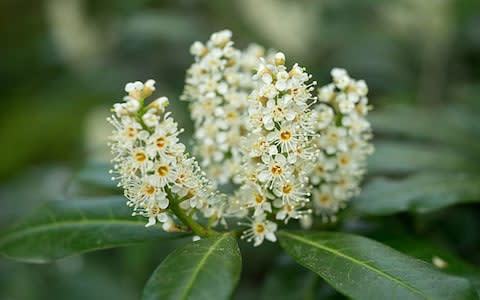Helen Yemm: chocolate cosmos tips, a laurel takeover, how to stop mealybug in its tracks

CHOCOLATE COSMOS
In my Northamptonshire garden, I have an enormous chocolate cosmos that is still in flower, with many buds yet to open (hopefully before the frosts). The trouble is that it is now too large for its position. Can I split it into smaller plants and, if so, when is the right time? Judith Watson – via email.
This is a tricky one for me to answer. I have always found chocolate cosmos to be the most disappointing and treacherous of herbaceous perennials. I have neither been overwhelmed by the scent that gave it its seductive name, nor have I managed to get it through an East Sussex winter.
I have to admit, however, that despite my considerable ongoing efforts to lighten it up, perhaps my soil is a little too heavy for this plant. Truth be told, over the years I have not given any of my (several) failures a site with quite enough uninterrupted sunshine, or even adequate space in which to expand. Indeed, Yemm could have tried harder – ’twas ever thus.
Even though you are not in a county notorious for bad winters, I would not leave things to chance. Lift this magnificent tuberous plant carefully this month. Either dry it off completely, remove any ropy bits and store it in a cool place in dry compost (as you might a similarly tuberous dahlia). Or simply put it in a large container with good, loam-based compost and provide it with a frost-free and dry billet for the winter months.
Either way, carefully check it for signs of life in early spring. Separate its best parts (each with a visible growing point or “eye”), pot up the divisions to get them started, and plant out the best in the ground again when spring is well under way. On this one, it’s a case of do as I say, not as I do. Good luck!

LAUREL LOW-DOWN
I have a shrub in my garden that has grown far too big over the years. I think it is called an aucuba. How much can I safely prune it back without it dying? Lisa Buckley – via email
Your accompanying picture showed two evergreens planted next to each other with names that could do with an explanation. One of them, a bright, variegated shrub (Aucuba japonica) commonly referred to as spotted laurel, is of fairly modest proportions and not a laurel at all. The other evergreen (presumably the one that is worrying you) is an enormous and overpowering cherry laurel (Prunus laurocerasus) – not a cherry, despite the name: in fact its berries are highly poisonous.

The one is not simply a variegated version of the other – they are (surprisingly) unrelated. Presuming I am right and that it is the big green beast (commonly called just laurel) that is the problem, the answer is that you can prune laurel really hard. It will come to no harm.
Drastic pruning (on all evergreens) is best done in late spring when the shrub will be growing strongly. However, new growth of your laurel may look wretched for the first season after a heavy cut. Foliage may appear mildewed and tatty (symptoms similar to those of shot hole disease).
Perhaps you would do well to be slightly kinder to your laurel and reduce its height and bulk in stages with the aid of pruning saw, loppers and secateurs over a couple of years.
MEALY BUG MAYHEM
We have a south-facing conservatory in which we grow various treasures, including a 40-year-old Black Hamburg grapevine. All are infested with mealy bug and none of our efforts to eradicate this pest have worked. Can you help? Jane Oldroyd – via email
Sap-sucking mealy bugs are hard to spot and are normally to be found on the stems or in leaf joints of indoor plants, although they will also feast on leaves, which then turn yellow. Eggs are laid in cotton-like pouches often described as “white wool”, and their excretions, “honeydew”, attract mould which turns black.
Blackened leaf surfaces may, in fact, be the first sign of an infestation and the effects on plants, therefore, look much like those caused by scale insects. If your failed efforts have involved chemicals, perhaps it is time to try a natural, biological (dog-eat-dog) method of control by introducing predatory larvae of Cryptolaemus (a type of ladybird) to your conservatory, that will themselves feed off the larvae of the mealy bugs.
Adults will thrive and breed in the warmth of a conservatory (although they will escape if doors or air vents are left open). Details of this and a parasitic wasp that also tackles mealy bugs are to be found, along with supplies of both, on the Defenders website (defenders.co.uk).


